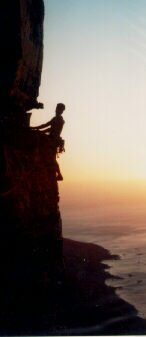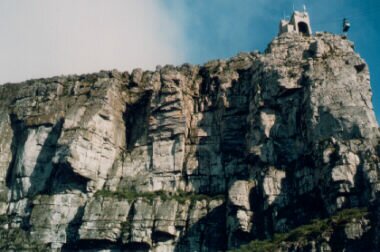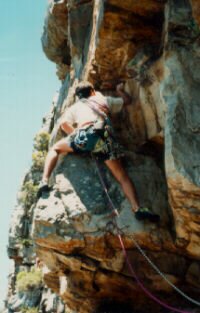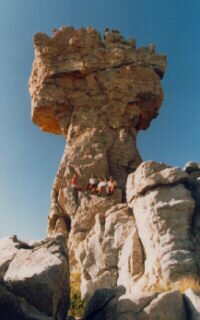Sunshine Climbing
in the Fairest Cape
 Cape Town local Brent Jennings gives the low-down on some of the more popular adventure climbing venues in the South Western Cape. Cape Town local Brent Jennings gives the low-down on some of the more popular adventure climbing venues in the South Western Cape.
An old Cumbrian was once met by a tourist after a week of persistent rain and asked if it ever did anything but rain there. "Yaas!" answered the dry old dalesman; "it sometimes snaws!" (GD Abraham in British Mountain Climbs - 1909.
Humour that may be, but how often has humour taken a back seat when, for the umpteenth time, bad weather has scuppered your plans for a climbing weekend? Or are you just tired of standing in a queue to get up that 'classic route', while the lucky early-comers, who had to bivvy at the crag to get their spot, drop their gear on your head from above? It's at times like these that you may think, "Hell, I need a holiday!" Hold that thought; there is a solution!
Cape Town, at the southern tip of the African continent, has much to offer. In particular, it has much to offer the climber. Imagine cutting loose on an overhang of white rock on immaculate grips high above picturesque mountain slopes covered in Protea and heath. Far below are the azure blue waters of the Atlantic ocean, endlessly rolling breakers onto white beaches where bronzed bods soak up the sun. Exposed faces, excellent protection and a feast of routes, ranging from scrambles to forearm-bulging, mind-twisting monsters. All in brilliant Mediterranean-style sunshine. Starting to sound a bit like an idyllic beer commercial? Well, with the ridiculously favourable exchange rate, foreign currency will buy you more than just a couple o' pints after cranking that crack in the warm sun!
Join me on a short trip around the traditional climbing areas in and around Cape Town. By no means comprehensive; it should nevertheless be sufficient to whet the appetite. At any rate, part of the joy of climbing in a new area is the discovery of that seldom-visited little crag that will only add spice to your climbing trip.
Geography
The South Western Cape is fortunate to have a Mediterranean climate. This means that the nasty weather is reserved for winter, and in summertime you are virtually guaranteed, uninterrupted sunshine and daylight from 5 in the morning 'til after 8 at night. Temperatures commonly range around the mid to late twenties in summer, but tend to increase as one progresses inland. Nonetheless, conditions can change rapidly and climbers are advised to equip accordingly.
The rock is mostly sandstone. No, not the crumbly, nasty stuff you may have had the misfortune to scratch around on before. Cape sandstone is as hard as British grit, but with a wealth of grips to offer. An impossible-looking, sheer wall may well provide a relatively easy route on closer inspection, with plenty of knotty gargoyle-like holds and good protection. There are some granite routes and a limited number of slate ones but the sandstone, in its many forms predominates.

Africa Face - some of the "classics" on Table Mountain
can be found on this part of the mountain
Peninsula climbs
Table Mountain
Those who have seen (either in photographs or before their eyes) the famous landmark of Table Mountain on the cape peninsula, should appreciate that it is here that South African mountaineering was born. The first recorded ascent of Table Mountain, via Platteklip Gorge, the prominent ravine on the city side of the mountain, was by Antonia da Saldanha in 1503. Overlooking the sea and the city of Cape Town, rising from sea level to a height of around 1000m it is home to more than 300 routes of all grades between easy scrambling and 30 (SA climbers have adopted the Australian grading system). The rock is sandstone and for the most part provides climbs of between three and eight pitches in length. Routes such as Jacob's Ladder (16), Atlantic Crag (19), Touch and Go (20), Triple Indirect (20) and Tour de Force (24) are but a very few of the best. A five minute cable car ride provides easy access to the summit of the mountain - a popular tourist venue. While cranking that route, be prepared to have yourself photographed by 'oohing and aahing' tourists passing overhead. Finally, grab a beer at the restaurant on the summit while you contemplate the perfect climb and watch the sun dip into the Atlantic.
Apostles
Part of the Peninsula mountain chain and a short distance from Table Mountain itself, are the Apostles. A series of rugged buttresses below which mountain slopes sweep into the sea along a thankfully largely undeveloped coastline. Here the peaceful solitude of the mountains can be gained while only a few minutes drive from the city; with climbs slightly longer and less likely to be observed by the passing populace. Feast on the unspoilt scenery, while sitting high on a ledge; or watch Black Eagles ( Aquila verreauxii), the subcontinent's largest eagle and sadly an endangered species, soar effortlessly by.
Lion's Head
The summit of this 690m peak offers 360° views around Cape Town. A popular spot for picnic lunches and full-moon strolls, Lion's Head offers several fine routes of moderate standard. Often climbed while paragliders glide past on their way to land on the beaches below.
Muizenberg Buttress
 Further south along the peninsula mountain chain, and overlooking False Bay, is Muizenberg buttress. A short walk brings you to a variety of climbs, some a tad chossy and overgrown, but others are classic gems. Most of the climbs are three to six pitch routes on rock of varying quality; ask the locals which routes in your grade are the ones to try. Further south along the peninsula mountain chain, and overlooking False Bay, is Muizenberg buttress. A short walk brings you to a variety of climbs, some a tad chossy and overgrown, but others are classic gems. Most of the climbs are three to six pitch routes on rock of varying quality; ask the locals which routes in your grade are the ones to try.
Elsie's Peak
Overlooking the bay above Fish Hoek stands Elsie's Peak. There are a number of fine, hard climbs on the cliffs here. Depending on the amount of bulge in your forearms (or dead insects in your skull), you can choose to do one of the classics such as Last of the Blacksmiths (21), or the immensely potent Dream Street Rose (27).
Granite Climbs
Two areas in the Cape offers granite climbs worth mentioning. The lower slopes of Lion's Head and Paarl Rocks, some 45 minutes drive from the city center.
Lions Head
This North facing crag can be hot in summer but does dry quickly in winter. It overlooks the ocean along the west coast and offers crack and slabs climbing of moderate to mildly severe standard.
Paarl Rocks
The largest granite climbing area in South Africa, the crag is essentially the remnant of a huge metamorphic intrusion in the shape of a massive dome that rises above the town of Paarl, a renowned and picturesque wine producing area. Single or multi-pitch routes ranging from roofs to slabs can be found alongside many bolted climbs. Test pieces include The Illearth Stone (26), and Blue Diamonds and White Ice (at grade 28 it is much harder than it looks!).
Country Climbing
A couple of hours drive from Cape Town will take you into the heart of some of the most rugged and beautiful mountain ranges in the country. These are the mountains of the Hottentots Holland, Hex River and Groot Winterhoek where are to be found some of the regions longest and most spectacular adventure climbs. Here an early morning start to your route is obligatory, and you can expect to spend the whole day ascending the rugged kloofs and amphitheatres of this remote region. Those in search of true solitude and that "summit experience" can bag a variety of peaks by some of the most spectacular routes. Grades range from 15 to 24, but there are several classic lines of greater difficulty including the recently freed Oceans of Fear (28). This route, one of the region's finest, can also be aided at a considerably more user-friendly 21. Multi-day routes such as this may sport the occasional bolt to improve protection on some of the harder moves. Cranking on rock, glowing deep orange from the setting sun, thousands of feet above glittering mountain streams in the valleys below, it is hard to believe that these peaks are snow-covered for most of the winter.
Hellfire
Nearby Hellfire crag offers a great variety of single-pitch climbs in the low to mid twenty range. Evocatively named to suit the brilliant oranges and reds of the cliffs where the sun can beat down mercilessly, the climbs are between 15 and 48 metres long. And names such as Scorched Earth (22), Blazing Brimstone (21) and Sizzling Salamanders (22), only add to the images already conjured up by the name hellfire.
Cederberg Mountains
 Two hours drive from the city will bring you to the mountain wilderness area of the Cederberg. A popular area for hikers, it is also home to some of the most varied and sensational climbing in the region. Camping is cheap, and cottages may be hired from local farmers. Venues worth a visit include the Cederberg Tafelberg, and the Wolfberg Cracks. The Cracks offer particularly awesome climbing. Orange sandstone cliffs rise majestically from the base of the crag. The quality of the rock is superb. One can only stand in awe for the many crack lines, clean faces and roofs that soar skywards. Solitude and exposure are in exquisite synergy on routes such as Energy Crisis (20), Alone in Space (22) and Celestial Journey (22). Two hours drive from the city will bring you to the mountain wilderness area of the Cederberg. A popular area for hikers, it is also home to some of the most varied and sensational climbing in the region. Camping is cheap, and cottages may be hired from local farmers. Venues worth a visit include the Cederberg Tafelberg, and the Wolfberg Cracks. The Cracks offer particularly awesome climbing. Orange sandstone cliffs rise majestically from the base of the crag. The quality of the rock is superb. One can only stand in awe for the many crack lines, clean faces and roofs that soar skywards. Solitude and exposure are in exquisite synergy on routes such as Energy Crisis (20), Alone in Space (22) and Celestial Journey (22).
Also in the Cederberg, the Krakadouw amphitheatre offers an immense wall with routes of many lengths and degrees of difficulty.
The Western Cape offers unique climbing potential. As mentioned earlier, this is by no means a comprehensive list of climbing areas, or the climbs in the areas. The staffed offices of the Mountain Club of SA, is always ready to help with advice and contact information. One may also enlist the services of a mountain guide. There are climbs to suit many grades and styles. Venture where your mood takes you, or simply allow yourself to be drawn by the beauty and grandeur of this mountain environment. And if it rains? Well... This is the country's principal wine making area, with wine farms spread far and wide in the valleys below the peaks. Go on, get tempted!
|

 Cape Town local Brent Jennings gives the low-down on some of the more popular adventure climbing venues in the South Western Cape.
Cape Town local Brent Jennings gives the low-down on some of the more popular adventure climbing venues in the South Western Cape.

 Further south along the peninsula mountain chain, and overlooking False Bay, is Muizenberg buttress. A short walk brings you to a variety of climbs, some a tad chossy and overgrown, but others are classic gems. Most of the climbs are three to six pitch routes on rock of varying quality; ask the locals which routes in your grade are the ones to try.
Further south along the peninsula mountain chain, and overlooking False Bay, is Muizenberg buttress. A short walk brings you to a variety of climbs, some a tad chossy and overgrown, but others are classic gems. Most of the climbs are three to six pitch routes on rock of varying quality; ask the locals which routes in your grade are the ones to try. Two hours drive from the city will bring you to the mountain wilderness area of the Cederberg. A popular area for hikers, it is also home to some of the most varied and sensational climbing in the region. Camping is cheap, and cottages may be hired from local farmers. Venues worth a visit include the Cederberg Tafelberg, and the Wolfberg Cracks. The Cracks offer particularly awesome climbing. Orange sandstone cliffs rise majestically from the base of the crag. The quality of the rock is superb. One can only stand in awe for the many crack lines, clean faces and roofs that soar skywards. Solitude and exposure are in exquisite synergy on routes such as Energy Crisis (20), Alone in Space (22) and Celestial Journey (22).
Two hours drive from the city will bring you to the mountain wilderness area of the Cederberg. A popular area for hikers, it is also home to some of the most varied and sensational climbing in the region. Camping is cheap, and cottages may be hired from local farmers. Venues worth a visit include the Cederberg Tafelberg, and the Wolfberg Cracks. The Cracks offer particularly awesome climbing. Orange sandstone cliffs rise majestically from the base of the crag. The quality of the rock is superb. One can only stand in awe for the many crack lines, clean faces and roofs that soar skywards. Solitude and exposure are in exquisite synergy on routes such as Energy Crisis (20), Alone in Space (22) and Celestial Journey (22).